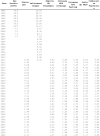Prevention and treatment produced large decreases in HIV incidence in a model of people who inject drugs
- PMID: 24590937
- PMCID: PMC4469974
- DOI: 10.1377/hlthaff.2013.0824
Prevention and treatment produced large decreases in HIV incidence in a model of people who inject drugs
Abstract
In the United States, people who inject drugs continue to be at greatly increased risk of HIV infection. To estimate the effectiveness of various prevention scenarios, we modeled HIV transmission in a dynamic network of drug users and people who did not use drugs that was based on the New York Metropolitan Statistical Area population. We compared the projected HIV incidence in 2020 and 2040 if current approaches continue to be used to the incidence if one or more of the following hypothetical interventions were applied: increased HIV testing, improved access to substance abuse treatment, increased use of needle and syringe programs, scaled-up treatment as prevention, and a "high impact" combination scenario, consisting of all of the strategies listed above. No strategy completely eliminated HIV transmission. The high-impact combination strategy produced the largest decrease in HIV incidence-a 62 percent reduction compared to the status quo. Our results suggest that increased resources for and investments in multiple HIV prevention approaches will be required to eliminate HIV transmission among people who inject drugs.
Keywords: AIDS/HIV; Epidemiology; Mental Health/Substance Abuse; Public Health; Special Populations.
Figures




Similar articles
-
Addressing the HIV/AIDS epidemic among Puerto Rican people who inject drugs: the need for a multiregion approach.Am J Public Health. 2014 Nov;104(11):2030-6. doi: 10.2105/AJPH.2014.302114. Epub 2014 Sep 11. Am J Public Health. 2014. PMID: 25211722 Free PMC article.
-
The risk of HIV transmission at each step of the HIV care continuum among people who inject drugs: a modeling study.BMC Public Health. 2017 Jul 25;17(1):614. doi: 10.1186/s12889-017-4528-9. BMC Public Health. 2017. PMID: 28738861 Free PMC article.
-
People who inject drugs in prison: HIV prevalence, transmission and prevention.Int J Drug Policy. 2015 Feb;26 Suppl 1:S12-5. doi: 10.1016/j.drugpo.2014.10.012. Epub 2014 Dec 1. Int J Drug Policy. 2015. PMID: 25727258
-
Key harm reduction interventions and their impact on the reduction of risky behavior and HIV incidence among people who inject drugs in low-income and middle-income countries.Curr Opin HIV AIDS. 2012 Jul;7(4):362-8. doi: 10.1097/COH.0b013e328354a0b5. Curr Opin HIV AIDS. 2012. PMID: 22647588 Review.
-
PEPFAR's evolving HIV prevention approaches for key populations--people who inject drugs, men who have sex with men, and sex workers: progress, challenges, and opportunities.J Acquir Immune Defic Syndr. 2012 Aug 15;60 Suppl 3:S145-51. doi: 10.1097/QAI.0b013e31825f315e. J Acquir Immune Defic Syndr. 2012. PMID: 22797736 Review.
Cited by
-
Systems Modeling to Advance the Promise of Data Science in Epidemiology.Am J Epidemiol. 2019 May 1;188(5):862-865. doi: 10.1093/aje/kwy262. Am J Epidemiol. 2019. PMID: 30877289 Free PMC article.
-
Marshall and Galea respond to "data theory in epidemiology".Am J Epidemiol. 2015 Jan 15;181(2):106-7. doi: 10.1093/aje/kwu273. Epub 2014 Dec 5. Am J Epidemiol. 2015. PMID: 25480819 Free PMC article. No abstract available.
-
Modeling the Impact of Social Determinants of Health on HIV.AIDS Behav. 2021 Nov;25(Suppl 2):215-224. doi: 10.1007/s10461-021-03399-2. Epub 2021 Sep 3. AIDS Behav. 2021. PMID: 34478016 Free PMC article.
-
Exploring the Use of Pre-exposure Prophylaxis (PrEP) for HIV Prevention Among High-Risk People Who Use Drugs in Treatment.Front Public Health. 2018 Jul 13;6:195. doi: 10.3389/fpubh.2018.00195. eCollection 2018. Front Public Health. 2018. PMID: 30062091 Free PMC article.
-
Combination interventions for Hepatitis C and Cirrhosis reduction among people who inject drugs: An agent-based, networked population simulation experiment.PLoS One. 2018 Nov 29;13(11):e0206356. doi: 10.1371/journal.pone.0206356. eCollection 2018. PLoS One. 2018. PMID: 30496209 Free PMC article.
References
-
- Centers for Disease Control and Prevention (CDC) HIV Infection and HIV-Associated Behaviors Among Injecting Drug Users - 20 Cities, United States, 2009. MMWR Morb Mortal Wkly Rep. 2012;61:133–138. - PubMed
-
- Mehta SH, Galai N, Astemborski J, et al. HIV incidence among injection drug users in Baltimore, Maryland (1988-2004) J Acquir Immune Defic Syndr. 2006;43(3):368–372. - PubMed
-
- Centers for Disease Control and Prevention. Estimated HIV Incidence in the United States, 2007-2010. HIV Surveillance Supplemental Report. 2012;17(4) Published December 2012 [cited 2013 Dec 7]. Available from: http://www.cdc.gov/hiv/topics/surveillance/resources/reports/-supplemental.
Publication types
MeSH terms
Grants and funding
LinkOut - more resources
Full Text Sources
Other Literature Sources
Medical

